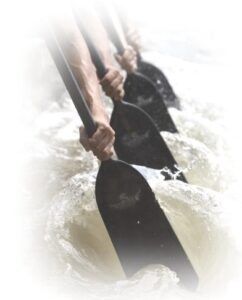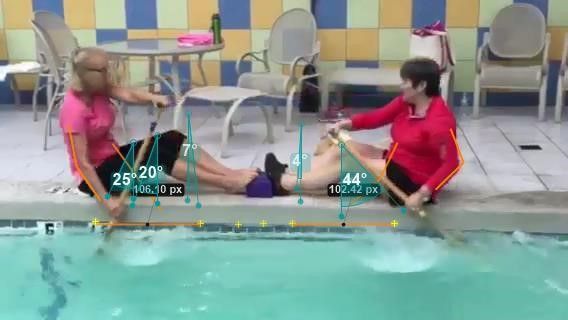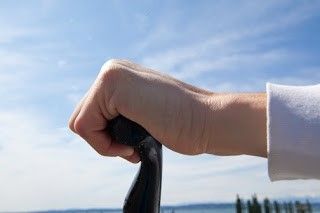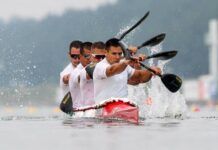Our tool for propulsion in a dragon boat is our paddle. It is a simple piece of technology which if used correctly, can help a team get nearly 2 tonnes of craft moving at 20km/hr or more. However, used inefficiently it can hinder the motion of the craft.
This post covers some of the technique errors specifically related to the paddle. There are many ways to use a blade to move a dragon boat. Different coaches encourage different paddle techniques, so there is a risk that some of the suggestions may conflict with what YOUR coach is training you to do. As always, if in doubt, follow the coach’s instructions.
Paddle “plopping” into the water
-
Description:
The paddle is entering the water at too steep an angle causing a “plopping” sound. Or the paddler is driving back before the paddle is buried.
-
Causes:

Figure 1: Driving before catch is complete - Top arm bent too much causing the angle of the blade to be too steep.
- Paddler is catching and driving at the same time drawing air down the back of the blade into the water.
-
How to fix:
- Set top arm to around 140 degrees. (not straight)
- Encourage a micro pause at the front of the stroke to ensure paddler is properly set up for the next stroke without having to rush through the catch.
- Encourage bottom hand to follow the blade tip into the same piece of water.
Paddle not vertical
-
Description:
The paddle should be vertical when looking from the back of the boat to the front. It should also be as close to the hull as practicable.
-
Causes:
- Top hand is inside the gunwale which causes the bottom hand to move away from the hull in an effort to avoid hitting bottom thumb on gunwale.
- Return too slow, forcing early catch before the paddle is set up properly. Common with higher stroke rates.
- Loss of twist due to fatigue or loss of concentration.
-
How to fix:
- Initially, emphasise top hand outside the gunwale at ALL times. If your technique involves dropping the top hand into the boat on return – park this until the top hand is consistently outside the gunwale on catch and power phase.
- Encourage paddler to periodically drag the bottom thumb along the hull on power phase. This will ensure the paddle blade is close to the hull and will force the top hand to make the paddle more vertical.
- Ensure the stroke is not too long at the back causing the slow return problem. If stroke length is OK, then encourage a quicker return. Train at a slower stroke rate until everyone can return completely. Otherwise, temporarily ask paddler to finish short at the back of the stroke to get plenty of time to set up for the next one.
- Ask paddler not to start the drive until the water touches the bottom hand. This ensures that the catch is complete.
- Ask the paddler to reach only as far forward needed to have enough movement left for the second action of burying the paddle.
- A little trickier to do. On the catch, pause for a micro second to feel the water push on the back of the blade – yes you are braking the boat for a micro second – but this ensures you are buried before pulling back.
Paddle blade going to a negative angle and lifting water

-
Description:
The angle of the blade is such that the bottom hand is behind the top hand causing a negative angle on the blade that, with power applied, will lead to water being lifted.
-
Causes:
- Top arm too straight causing the top hand to “roll over” the bottom hand.
- The stroke is too long at the back. Bottom hand passes hip while top hand remains over the knee.
- Bottom elbow being bent too early in the stroke.
-
How to fix:
- Get top arm set at around 140 degrees.
- Keep the stroke length (if that is what your coach wants) but move whole stroke forward. That is, catch further out front and stop shorter at the back.
- Keep the bottom arm straighter for longer in the drive phase of the stroke.
- Encourage the paddler to manipulate their body to ensure that the top hand stays behind or level with the bottom hand for as long as possible.
Paddle blade twisted in the water
-
Description:

Figure 4: Left good. Right no good. Blade is moving through the water with a twist on it causing the water pressure on the blade to slip off the face. This leads to an inefficient stroke.
-
Causes:
- Top hand, wrist and arm in line outside the gunwale.
- Torso not leaning enough out of the boat.
-
How to fix:
- Introduce a slight twist in the wrist to ensure blade is square on entry to the water.
- Lean slightly out of the boat to ensure the required twist in the wrist is not too pronounced.
- If required, change the grip on the handle to ensure a squared off blade.

Figure 5: Always ensure your wrist is in line with your forearm

Bottom hand too far up the blade

-
Description:
Bottom hand is too far up from the blade causing the paddler to lose control of the blade during the power stroke (blade wobbles through the water). Note that moving your hand up the paddle shaft is equivalent to changing gears. Some elite paddlers start off with their bottom hand one hand width above the blade while others shift their hand up during the race. As the hand moves up, the effort required increases but the leverage improves.
-
Causes:
- Bottom hand is set too far up the paddle.
- Bottom hand slips up the paddle.
- Paddle is too long.
- Top and bottom hands not moving in tandem.
-
How to fix:
- Ensure that the paddle is the right length.
- Ensure that inside shoulder movement is adequate to lift the paddle up on the return.
- Encourage the use of tape to mark the location of the bottom hand.
- Encourage the use of wax if hand slipping is the problem.
- Ensure that both hands are working together with the blade.
1 Images from https://sites.google.com/site/unidragonsact/technique














